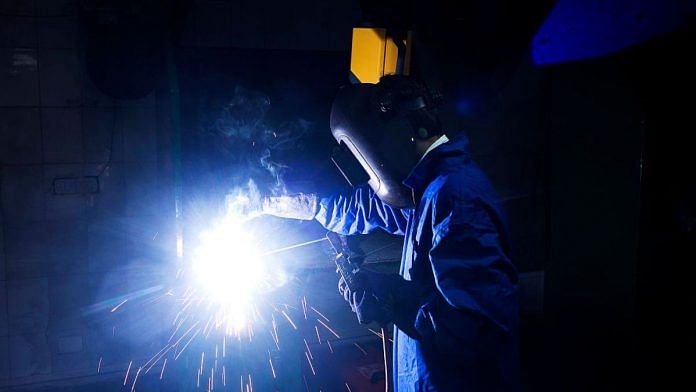As nearly a billion Indians go to the polls this month and next, no one doubts jobs will be central to their vote. We just can’t agree on whether the employment picture is rosy or dark. While the government cites payroll data to claim significant job creation, the opposition holds up a leaked preliminary report that pegged unemployment in 2017 at 6.1 percent, which if true would be the highest rate in 45 years.
It might be more useful instead to concentrate on the most recent numbers we can all agree on, which come from a government survey of over 150,000 households across India between April and December of 2015. Although dated — it was conducted before demonetization and the introduction of a nationwide goods-and-services tax — the survey reveals several interesting things about employment in India, including one trend of particular relevance to policymakers and another to jobseekers.
The data suggest that, at least in 2016, unemployment hovered around 5 percent. More worryingly, the labor force participation rate stood at an unusually low 50 percent, meaning only half the working-age population was actively working or seeking employment. By comparison, China’s labor participation rate averaged 75 percent from 1990 to 2017. Rates in other emerging Asian economies such as Vietnam (77 percent), Indonesia (70 percent), Thailand (69 percent) and Bangladesh (57 percent) are typically much higher as well.
Among those who are participating, the situation varies greatly depending on where they live. Dynamic states which are actively improving their ease of doing business — including Chhattisgarh (1.9 percent), Karnataka (1.5 percent) and Gujarat (0.9 percent) — recorded the lowest unemployment rates. By contrast, progressive states that have scored well on human-development indicators such as literacy and maternal health don’t seem to be great job-creators: Unemployment in Kerala came in at 12.5 percent, while in Tripura and Himachal Pradesh it stood at 19.7 percent and 10.6 percent respectively. Not surprisingly, these states have lagged in improving their business environment.
The trend holds true when one drills down into specific categories of workers as well. It’s remarkable that states that have generally fared well on social indicators nevertheless register alarmingly high levels of female unemployment — as high as 30 percent in Kerala. By contrast, the states generating most jobs have spread the wealth to women as well as men: Karnataka, Chhattisgarh and Gujarat have female unemployment rates as low as 2 percent, 1.8 percent, and 1.1 percent respectively. (Even there, however, the rates of female labor force participation remain disturbingly low, as they do across the country.)
Similarly, while unemployment is higher among youth in India (13.5 percent) than those over 30 years of age (1.5 percent), as it is in much of the world, economically dynamic states have also found jobs for younger workers. Gujarat (2.7 percent) and Karnataka (4.4 percent) have the least youth unemployment, while states which rank low on the ease of doing business, including Kerala (29.7 percent), Himachal Pradesh (32 percent) and Tripura (36.7 percent) report particularly high levels of youth unemployment.
If all that should persuade politicians from all parties of the need to focus on eliminating red tape and promoting investment-friendly policies, the numbers also contain sobering lessons for new job-seekers. What stands out is how concentrated unemployment is among the most-educated young Indians. Unlike in developed economies, where jobs increasingly flow to the better-educated, in India the trend is the opposite. Nearly 35 percent of Indian youth who possess graduate degrees and above are unemployed, while relatively uneducated young workers (6.2 percent unemployment) are doing much better. A highly educated Indian youth is more than five times as likely to be unemployed as an uneducated one.
Why might this be? The gap probably says something about the quality of the jobs being created, with most involving mundane or repetitive tasks. It also says something about the quality of Indian education: Too many engineers and other professionals are waving around degrees that are relatively worthless.
The latter raise expectations without providing necessary skills, so graduates prefer to remain unemployed rather than accept work that seems beneath their station. Some believe their time is better spent preparing for further tests and qualifications so they can, for instance, win particularly prized positions such as those in the government.
Leaders certainly have a responsibility to improve education and to generate more high-quality jobs. Until they do, however, at least some Indian youth need to think harder about whether a vocational education would serve them better than a fine-sounding degree. A little realism might brighten the jobs picture just a bit. – Bloomberg
Also read: Modi & BJP have chosen not to counter Congress’s claims on jobs, and it’s the right strategy







The government has been claiming that with huge infrastructure and road construction there is large scale employment. The fact is most of work are now less labour oriented. Road laying is now automated. I have been seeing a small apartment under construction and very few workers are used as even to lift brick, cement they are using automatic pully. Unless we get large scale industry working more than two shifts, employment would get generated
As quality of education depletes millions of poor quality freshman have flooded the market